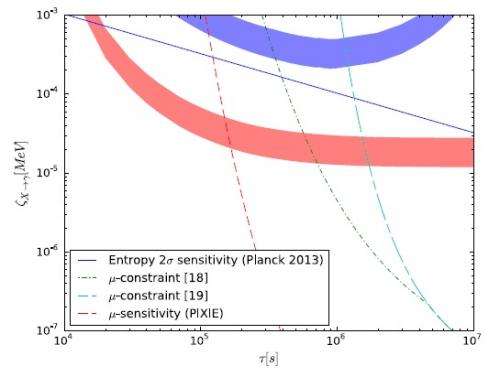March 12, 2015 feature
Loophole in theory offers insight into the 'lithium problem'

(Phys.org)—There's not as much lithium in the universe as predicted, and scientists aren't sure why. According to the theory of big bang nucleosynthesis (BBN), isotopes of the three lightest elements—hydrogen, helium, and lithium—were created within the first 20 minutes after the big bang. The theory predicts with remarkable accuracy the observed amounts of hydrogen and helium, but its estimate for lithium is three times too high.
The problem has frustrated scientists working in cosmology, since almost any modification to the BBN theory that corrects the lithium abundance inadvertently throws off the hydrogen or helium abundances, or contradicts other constraints on the theory. The situation may be compared to trying to solve a Rubik's cube that has only one square of the wrong color.
Now in a new paper published in Physical Review Letters, physicists Vivian Poulin and Pasquale Dario Serpico at Université Savoie Mont Blanc, CNRS, in Annecy-le-Vieux, France, have suggested that the lithium problem may be connected to an overlooked loophole in another theory: that of electromagnetic cascades. Although addressing the lithium problem is not the main result of the paper, it illustrates the potential impact of these broader findings.
"The general result we found in our paper is not specifically related to the lithium problem, rather to the inaccuracy of an approximation used to describe perfectly standard physics, related to cascades," Serpico told Phys.org.
An electromagnetic cascade refers to the cascade of particles produced from a collision between photons and/or electrons. Such a collision results in a chain of reactions in which energy is redistributed among larger numbers of particles, where the energy per particle decreases.
The standard theory of electromagnetic cascades describes this redistribution of energy by predicting a specific shape of the spectrum of photon energies in the cascade. Many different areas of research, including BBN theory, have used this spectral shape when developing models of various phenomena, such as the production of the light elements.
Here, Poulin and Serpico show that, in some cases, this distribution of energy should be computed differently. They point to a previously known but often-overlooked exception to this spectral shape: when the energy of the colliding photon falls below a certain level, the spectral shape deviates from the normal predicted shape. This change could have many consequences, one of which concerns the lithium problem.
"More high-energy photons are present in the correctly computed spectrum than in the approximation typically used in the literature," Poulin said. "Such energetic photons are more effective in destroying lithium, making it easier for particle physics models to solve the disagreement while remaining consistent with other observations or constraints."
The scientists found that, in one simple and realistic scenario, the theory accurately predicts the observed amount of lithium (i.e., 1/3 of the current prediction), while at the same time satisfying all of the other BBN constraints and cosmological bounds that have plagued previous attempts.
How can higher-energy photons have such a large impact? The scientists explain that, in standard BBN, lithium is produced in a reaction in which the beryllium isotope 7Be decays into the lithium isotope 7Li. The beryllium originally comes from the fusion of two helium isotopes, a reaction that takes place in the thermal medium. When the photons in the thermal medium have higher energies, they favor the reverse reaction, resulting in more helium and less beryllium. With less beryllium, not as much lithium is produced as previously thought.
"A consequence of our results is that it is easier to solve the lithium problem in a broad class of new physics models, so to speak," Serpico said. "More in general, we would say that the importance of the lithium problem is due to its long-standing nature; it goes back to the beginning of the millennium and, despite several alternatives (both standard and exotic), none of them has been conclusively argued to be 'the one.' Concerning implications: If the solution is due to new physics, there will be profound implications for theories beyond the standard model as well as their impact on the early universe. Alternative classes of solutions may involve subtle aspects of stellar astrophysics, for instance. Hence, even more mundane explanations are typically not trivial at all."
In the future, the scientists plan to apply the results to other situations that may be affected by the loophole, and consider some of these cases even more urgent than the lithium problem.
"In particular, an obvious case is provided by big bang nucleosynthesis constraints on unstable relics, based on deuterium and helium measurements and for photons having a broader energy range (from a few MeV to hundreds of MeV)," they wrote. "This is a calculation we are currently completing.
"Of course, given its importance, we are also thinking about particle physics models that may 'exploit' the features we have pointed out, in order to provide a more efficient solution to the lithium problem. Linking these results to the problem of the nature of dark matter or other signatures of particle physics beyond the standard model (for instance in the neutrino sector) is certainly on our medium-term agenda."
More information: Vivian Poulin and Pasquale Dario Serpico. "Loophole to the Universal Photon Spectrum in Electromagnetic Cascades and Application to the Cosmological Lithium Problem." Physical Review Letters. DOI: 10.1103/PhysRevLett.114.091101
Journal information: Physical Review Letters
© 2015 Phys.org




















